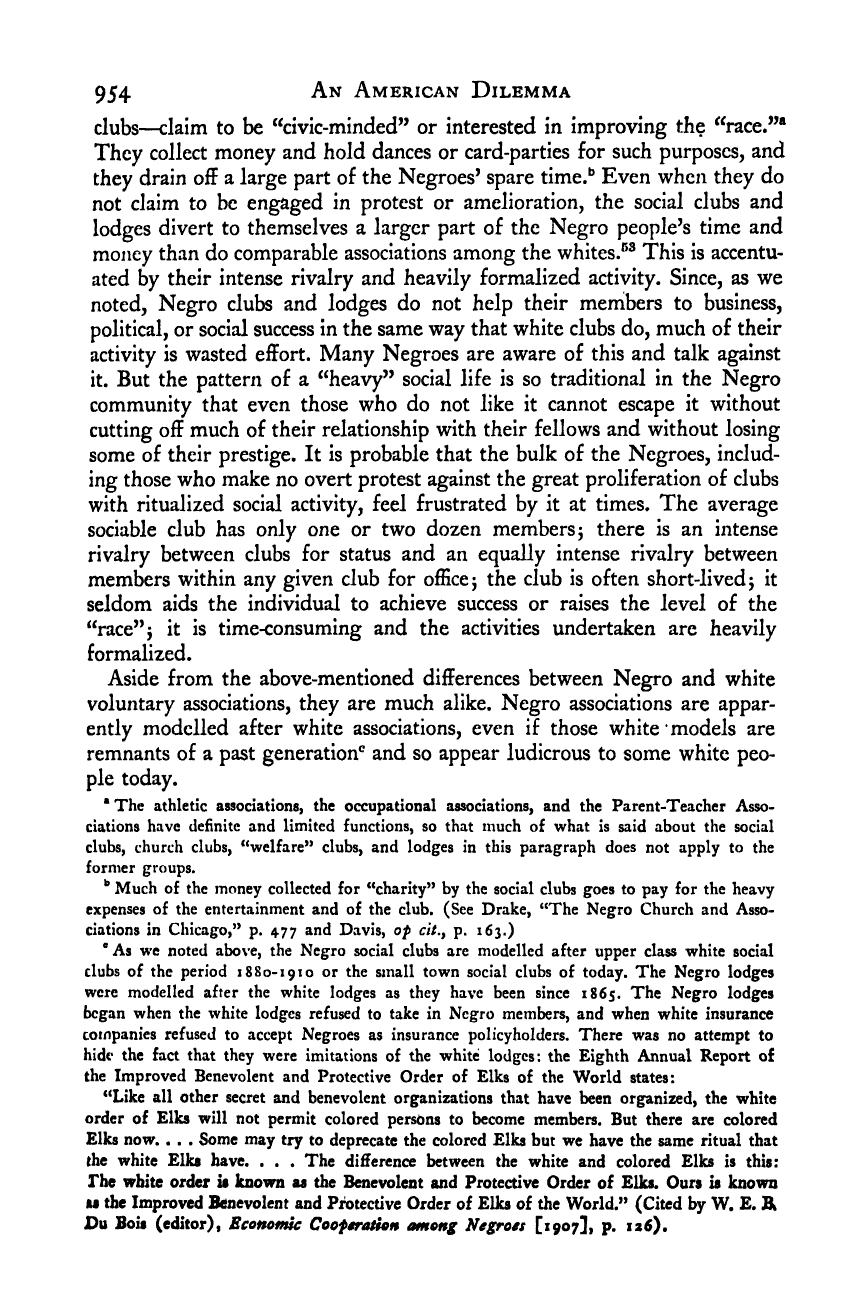Note: Gunnar Myrdal died in 1987, less than 70 years ago. Therefore, this work is protected by copyright, restricting your legal rights to reproduce it. However, you are welcome to view it on screen, as you do now. Read more about copyright.
Full resolution (TIFF) - On this page / på denna sida - X. The Negro Community - 43. Institutions - 5. Voluntary Associations

<< prev. page << föreg. sida << >> nästa sida >> next page >>
Below is the raw OCR text
from the above scanned image.
Do you see an error? Proofread the page now!
Här nedan syns maskintolkade texten från faksimilbilden ovan.
Ser du något fel? Korrekturläs sidan nu!
This page has never been proofread. / Denna sida har aldrig korrekturlästs.
An American Dilemma
954
clubs—claim to be ^^civic-minded” or interested in improving the ^^race.”®
They collect money and hold dances or card-parties for such purposes, and
they drain off a large part of the Negroes’ spare time.^ Even when they do
not claim to be engaged in protest or amelioration, the social clubs and
lodges divert to themselves a larger part of the Negro people’s time and
money than do comparable associations among the whites/’^ This is accentu-
ated by their intense rivalry and heavily formalized activity. Since, as we
noted, Negro clubs and lodges do not help their members to business,
political, or social success in the same way that white clubs do, much of their
activity is wasted effort. Many Negroes are aware of this and talk against
it. But the pattern of a “heavy” social life is so traditional in the Negro
community that even those who do not like it cannot escape it without
cutting off much of their relationship with their fellows and without losing
some of their prestige. It is probable that the bulk of the Negroes, includ-
ing those who make no overt protest against the great proliferation of clubs
with ritualized social activity, feel frustrated by it at times. The average
sociable club has only one or two dozen members; there is an intense
rivalry between clubs for status and an equally intense rivalry between
members within any given club for office; the club is often short-lived; it
seldom aids the individual to achieve success or raises the level of the
“race”; it is time-consuming and the activities undertaken are heavily
formalized.
Aside from the above-mentioned differences between Negro and white
voluntary associations, they are much alike. Negro associations are appar-
ently modelled after white associations, even if those white models are
remnants of a past generation^ and so appear ludicrous to some white peo-
ple today.
• The athletic associations, the occupational associations, and the Parent-Teacher Asso-
ciations have definite and limited functions, so that much of what is said about the social
clubs, church clubs, “welfare” clubs, and lodges in this paragraph does not apply to the
former groups.
**
Much of the money collected for “charity” by the social clubs goes to pay for the heavy
expenses of the entertainment and of the club. (See Drake, “The Negro Church and Asso-
ciations in Chicago,” p. 477 and Davis, op cit.^ p. 163.)
* As we noted above, the Negro social clubs arc modelled after upper class white social
clubs of the period 1880-1910 or the small town social clubs of today. The Negro lodges
were modelled after the white lodges as they have been since 1865. The Negro lodges
began when the white lodges refused to take in Negro members, and when white insurance
companies refused to accept Negroes as insurance policyholders. There was no attempt to
hide the fact that they were imitations of the white lodges: the Eighth Annual Report of
the Improved Benevolent and Protective Order of Elks of the World states:
“Like all other secret and benevolent organizations that have been organized, the white
order of Elks will not permit colored persons to become members. But there are colored
Elks now. . . . Some may try to deprecate the colored Elks but we have the same ritual that
the white Elks have. , . . The difference between the white and colored Elks is this:
The white order is known as the Benevolent and Protective Order of Elks. Ours is known
ss the Improved Benevolent and Protective Order of Elks of the World.” (Cited by W, E. Bi
Du Bois (editor), Econofnic Coofgraven among Negroes [1907], p. iz6).
<< prev. page << föreg. sida << >> nästa sida >> next page >>